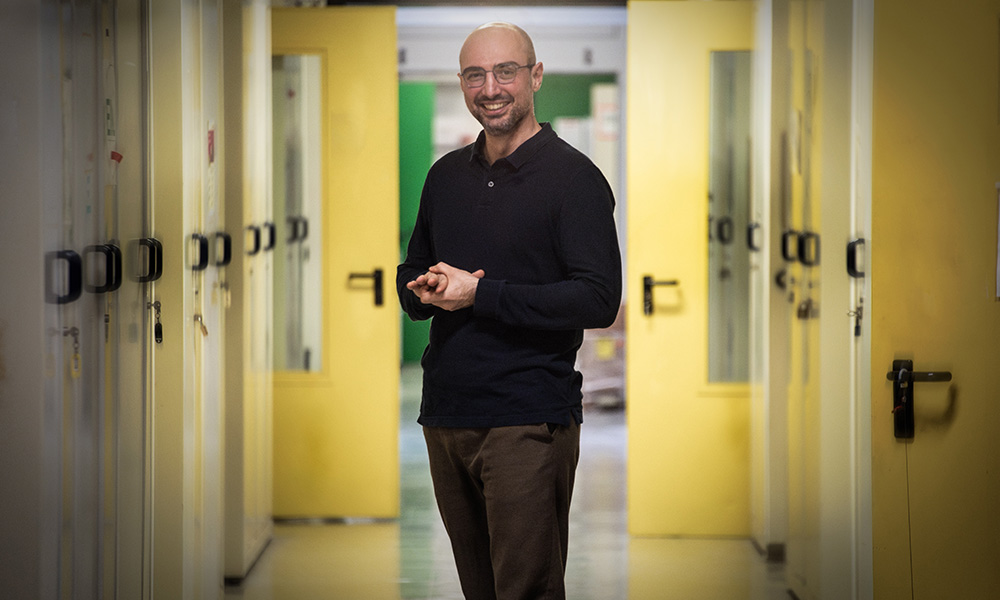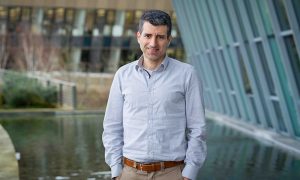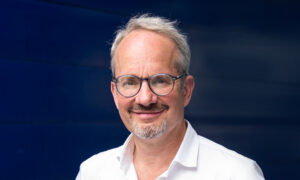
Welcome: Fabio Petroni
After many years abroad, Fabio Petroni has returned to Italy to establish his research group at EMBL Rome, where he is leading a project focused on developing AI systems to support life science research

Born and raised in Monterotondo, where EMBL Rome is based, Fabio Petroni holds a degree in computer engineering and a PhD from Sapienza University of Rome. His passion for artificial intelligence marked the beginning of an international career that now brings him back to Monterotondo as a new group leader at EMBL.
After his studies and various experiences abroad, Petroni joined Meta AI in 2018, working in the Fundamental AI Research (FAIR) team dedicated to advanced research in artificial intelligence systems. He worked extensively on knowledge-intensive natural language processing (NLP), which enables machines to understand, use, and generate information from large datasets.
In one of his studies, he demonstrated how large language models (LLMs) can not only store, but also retrieve knowledge from the parameters they are trained on, effectively functioning as knowledge bases. This research highlighted a dual role of LLMs as both reasoning engines and knowledge repositories.
While at Meta AI, he was also part of the research team that developed RAG (retrieval-augmented generation). RAG is a fundamental technology that allows language models such as ChatGPT, Gemini, and others to provide more complete and accurate information. RAG combines search functions with text generation, allowing AI to retrieve up-to-date information from external sources while generating responses.
In 2022, he co-founded Samaya AI, where he applied his expertise to creating a knowledge discovery platform for financial professionals.
We recently had the chance to talk to Petroni about his career journey, future research focus, and his return to Monterotondo.
How did you transition from Big Tech to fundamental biological research?
Rather than a sudden switch, I see it more as a journey – always driven by a passion for research. At Meta AI, I explored fundamental questions about how AI systems work and how to improve them. At Samaya, I applied that knowledge to real-world needs and observed how actual users interacted with the tools we developed.
EMBL represents the ideal combination of these two experiences: on the one hand, it offers access to unique experimental data and infrastructure; on the other, it allows me to work side-by-side with wet lab researchers. This context will let me directly test the effectiveness of the systems we develop and evaluate their impact on biological research.
What is the research focus of your group at EMBL?
Our goal is to build AI systems that can reason over multimodal data by integrating information from diverse sources: scientific literature, microscopic imaging, experimental results, and more.
This will enable us to develop intelligent agents that can assist researchers in their day-to-day work: proposing hypotheses and experiments, monitoring and adapting experimental processes in real time, and contributing to a more efficient and targeted scientific process.
In the near future, I imagine AI as a cognitive member of the research team that is able to proactively coordinate the experimental process, automate repetitive tasks, and thereby enable researchers to focus on the more strategic and creative aspects of scientific discovery.
How did you become interested in applying AI to life sciences?
My work has always focused on retrieving and using knowledge from large volumes of data. In this sense, life sciences are an ideal field: the amount of available data is growing rapidly, but the ability to turn it into useful knowledge is still limited and fragmented.
The potential for AI in this domain is enormous, as confirmed by the 2024 Nobel Prize in Chemistry awarded to AlphaFold. But what’s especially compelling to me is the impact these technologies can have; accelerating drug discovery or understanding disease mechanisms can literally save lives.
At EMBL, I found the perfect environment to shape this research. I was impressed not only by the institute’s scientific excellence and cutting-edge infrastructure, but also by the strong integration between computational and experimental research. This is something rare, yet essential to advancing AI applications in life sciences.
EMBL also attracts talent from all over the world, which is key to building a competitive and dynamic research group.
The broader context is also incredibly stimulating; my group is part of a distributed network across EMBL’s sites, which has driven the development of the institute’s AI strategy. The ambition is bold: to integrate AI technologies into all areas of biological research. Working in an organisation with such a clear strategic vision, alongside researchers who pioneered AI applications in life sciences, gives me the feeling of being in the right place – and constantly drives me toward collaboration and knowledge sharing.
On a personal level, what does it mean for you to return to Italy and to Monterotondo in particular?
Coming back here means having the possibility to build something of international relevance in the place where I grew up. It’s a rare opportunity that I also see as a responsibility.
On a personal level, it also means reconnecting with my roots: my family, friends, and the local community.
How do you recharge your batteries outside of work?
Spending time with friends and family is what really helps me recharge. Sharing a meal, a glass of wine, or picking up the guitar and singing together. I also enjoy being outdoors and in nature, and now in Monterotondo I’ll have the chance to spend more time with a few Labradors, all descendants of our old family dog.


